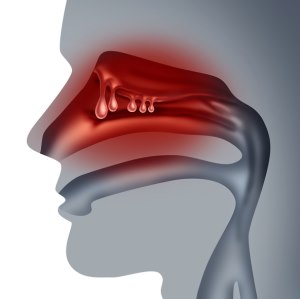What is the role of fungus in allergic airway diseases? VA researchers found that many conditions, including chronic rhinosinusitis (CRS), allergic fungal rhinosinusitis, asthma, allergic bronchopulmonary mycosis/aspergillosis, and cystic fibrosis (CF have a shared immunological signature. In some cases, nasal polyps can occur.

The American Academy of Allergy, Asthma & Immunology advises that chronic rhinosinusitis (CRS), which involves inflammation of the nose and sinus cavities, is one of the most common medical conditions worldwide, reported to affect almost 12% of the adult population. About 20% of patients with CRS have nasal polyps, benign growths in the nasal cavities that are thought to originate from the ethmoid sinuses and tend to be present in both sides of the nasal cavity, according to AAAAI. Source: AAAAI
HOUSTON — While the isolation of the pandemic increased awareness of the importance of human interaction and community in the world beyond ourselves, the last 20 years have transformed understanding of the importance of community interaction in the world within ourselves. The trillions of organisms that reside on and inside us play critical roles in the functioning of the brain and gut, affect personality, and drive a wide range of immune responses.
Until quite recently, the study of microbiota largely focused on bacteria: how antibiotic use and misuse affected intestinal and vaginal bacteria, for instance, or what beneficial colonies could be introduced by fecal transplants. Similarly, studies of sinus cavities and airways have sought to better understand both the impact of diminished bacterial diversity in inflammation and the pathologic role of bacteria in chronic rhinosinusitis and other inflammatory diseases.
Researchers at the Michael E. Debakey VA Center for Translational Research in Inflammatory Diseases, along with colleagues at the McGovern Medical School of the University of Texas Health Sciences Center and the Baylor College of Medicine, all in Houston, looked instead at the role of fungus in allergic airway diseases in a recent study.1
They noted that many of these conditions, including chronic rhinosinusitis (CRS), allergic fungal rhinosinusitis, asthma, allergic bronchopulmonary mycosis/aspergillosis, and cystic fibrosis (CF), have a shared immunological signature. All generate a T helper type 2 (Th2) immune response or type 2 immune response, along with a Th17 immune response, innate lymphoid cells (ILC) 2, production of IgE antibodies and infiltrating eosinophils.
“Severe forms of these disorders have long been recognized as being related to hypersensitivity reactions to environmental fungi,” wrote Houston VA researchers Farrah Kheradmand, MD, and David Corry, MD, and their colleagues. “Increasingly, however, environmental fungi are assuming a more primary role in the etiology of these disorders, with airway mycosis, a type of non-invasive airway fungal infection, recognized as an essential driving factor in at least severe subsets of allergic airway disease.”
The growth of fungi on the sino-mucosal surface stimulates distinct responses in line with the individual’s immune status. In immunocompromised people, such as those with diabetes, invasive fungal sinusitis develops, with angioinvasion and increased risk of damage to endothelial cells. In immunocompetent individuals, fungal balls emerge, and the inflammation remains confined to the affected sinus with no tissue infiltration.
Nasal Polyps
The third presentation, allergic fungal rhinosinusitis (AFRS), a type of chronic rhinosinusitis with nasal polyps (CRWwNP), arises in immunocompetent people with an atopic background. Their hypersensitivity to fungal allergens generates an excessive type 2 immune response, while a defective mucosal barrier and fungi-activated molecular signaling contribute to the development of nasal polyps.
While there is no doubt that fungus has a central role in allergic bronchopulmonary mycosis/aspergillosis (ABPA), expanding the criteria for its diagnosis may allow for better treatment outcomes. The Rosenberg-Patterson criteria, the most commonly used criteria for diagnosis, “call for the strict adherence to several metrics that make the diagnosis of ABPA exceedingly difficult and likely leading to significant underestimation of the true prevalence of this condition,” the authors note. In particular, expanding the criteria to include individuals without asthma of cystic fibrosis would enable more patients to find relief through the use of antifungal therapies in addition to first-line systemic corticosteroids.
A number of biologics and other new therapies have joined the treatment armamentarium in recent years. With greater understanding of the immune system response, monoclonal antibodies including omalizumab, mepolizumab and dupilumab are under study, particularly for CF and ABPA. Novel delivery systems for corticosteroids also provide an option beyond systemic treatment to reach deep into sinus cavities to treat fungus-induced CRS with nasal polyps.
Corry and other researchers also recently studied use of a small molecule antagonist of signal transducer and activator of transcription 6 (STAT6) and STAT 5. Both prove necessary for the expression of airway mycosis-dependent asthma, and blocking their ability to transactivate key asthma-related genes effectively prevented and even reversed airway hyperresponsiveness in airway mycosis-related asthma in mice.2
“These discoveries portend exciting future research that will further unlock the mechanisms by which molds, but also yeasts, elicit allergic inflammation that will in turn inform future clinicians as to improved diagnostic and therapeutic approaches,” the VA researchers and their colleagues concluded. “Undoubtedly, these additional findings will extend to other diseases related to fungi.”
- Li E, Rodriguez A, Luong AU, Allen D, Knight JM, Kheradmand F, Corry DB. The immune response to airway mycosis. Curr Opin Microbiol. 2021 Aug;62:45-50. doi: 10.1016/j.mib.2021.04.009. Epub 2021 May 27. PMID: 34052540; PMCID: PMC8286351.
- Sun H, Damania A, Mair ML, Otukoya E, Li YD, Polsky K, Zeng Y, Alt JA, Citardi MJ, Corry DB, Luong AU, Knight JM. STAT6 Blockade Abrogates Aspergillus-Induced Eosinophilic Chronic Rhinosinusitis and Asthma, A Model of Unified Airway Disease. Front Immunol. 2022 Feb 23;13:818017. doi: 10.3389/fimmu.2022.818017. PMID: 35281012; PMCID: PMC8904741.

